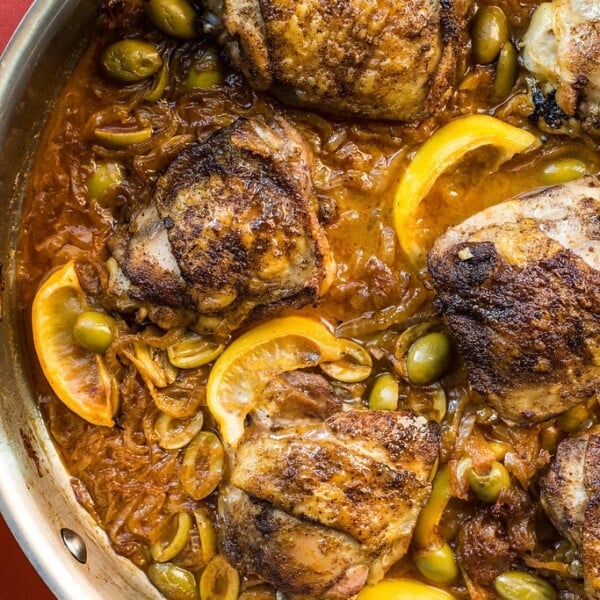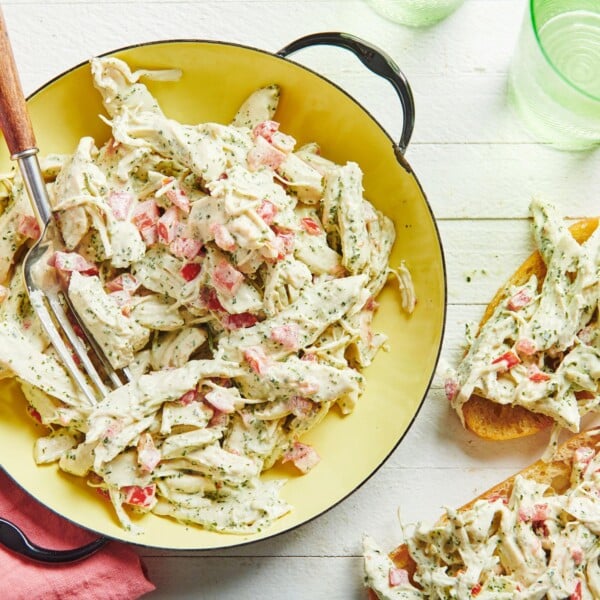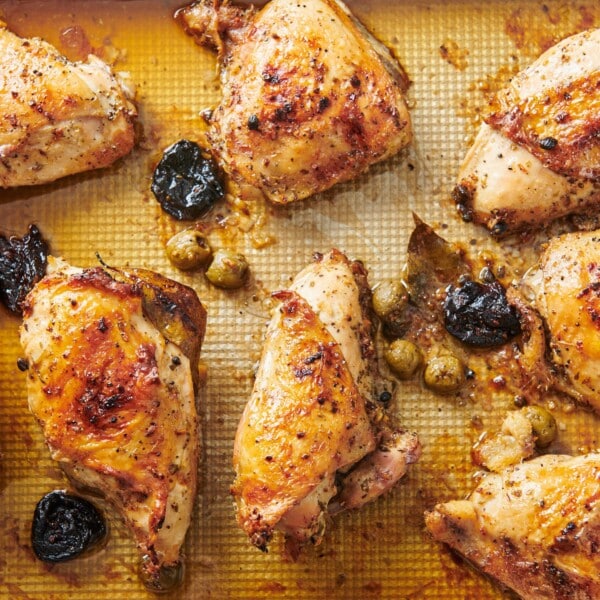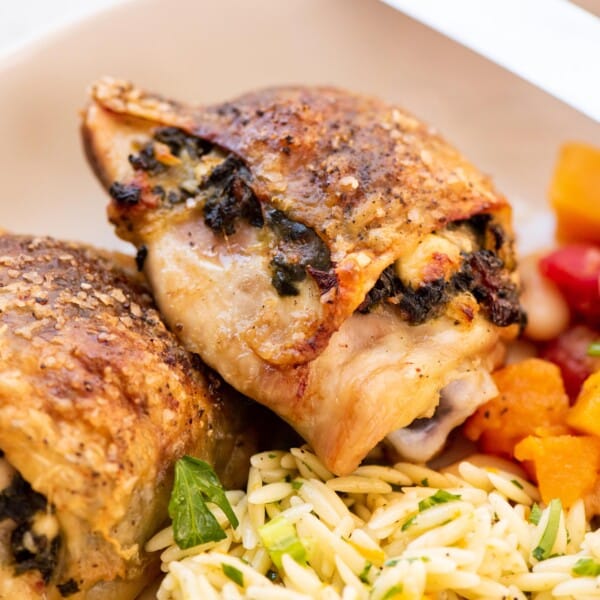How to Poach Chicken
on May 25, 2022, Updated May 04, 2023
This post may contain affiliate links. Please read our disclosure policy.
Perfect tender, delicate, moist poached chicken every time.
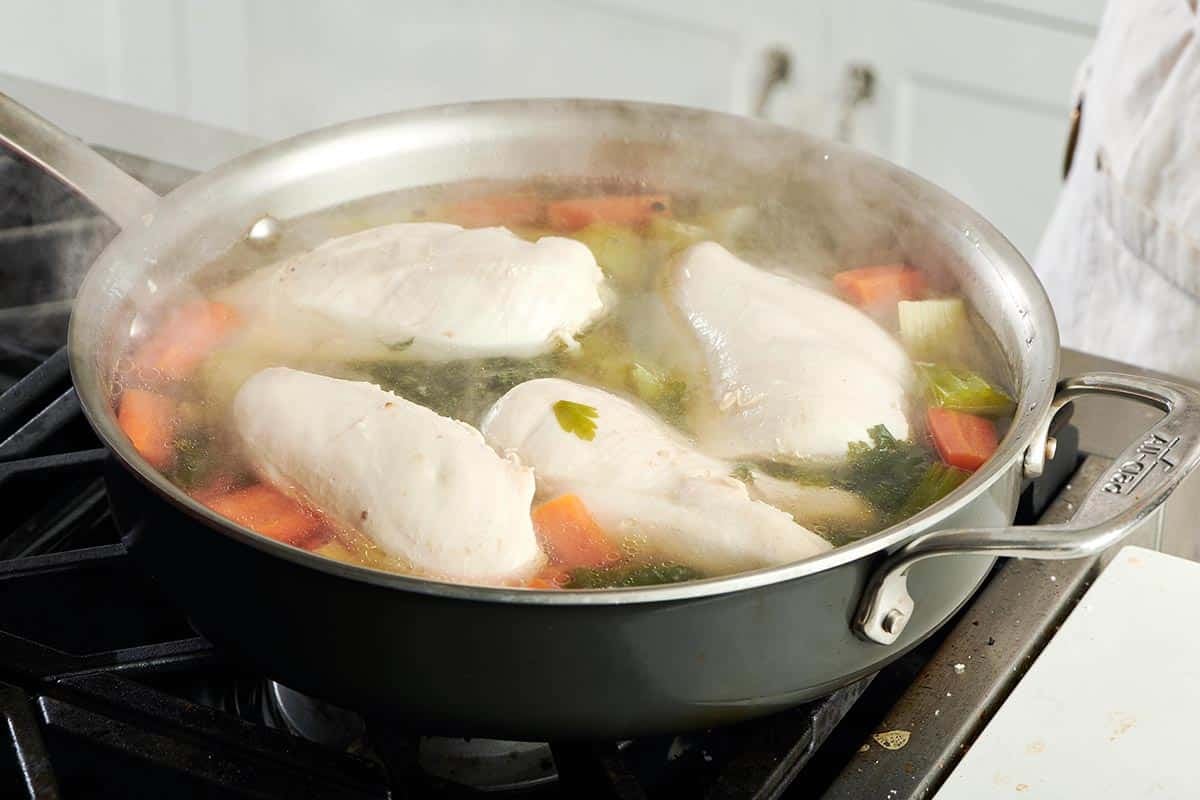
Poached Chicken
Poaching chicken breasts is a simple, healthy way to prepare chicken which can be eaten as is, or incorporated into all kinds of recipes. There are endless uses for poached chicken breasts – just a few handfuls of ideas below!
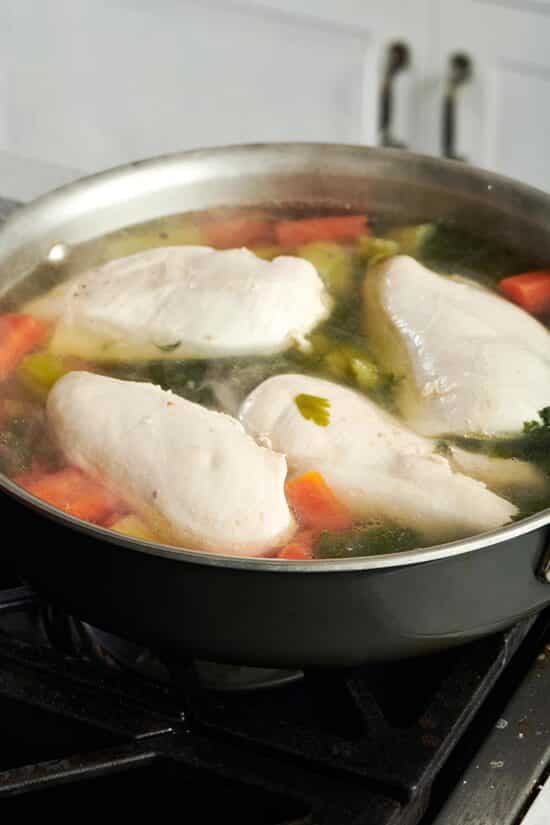
Poaching chicken is very easy. It is essentially covering the chicken with water with added ingredients, or now) and letting it simmer gently on the stove until the chicken is cooked through. The combination of a low cooking temperature and the wet cooking method result in chicken that is very tender, as long as you don’t overcook it.
Also see Slow Cooker Shredded Chicken!
What are Aromatics?
Aromatics is a culinary term for vegetables and herbs that are added to a dish or cooking method to provide additional flavor. Common aromatics are onions, leeks, carrots and celery, plus some basic herbs like parsley. However, pretty much any vegetables and herbs can be considered aromatics. You should feel free to brose around in your fridge when you are making poached chicken or whenever you are looking to add flavor and use up what you have on hand.
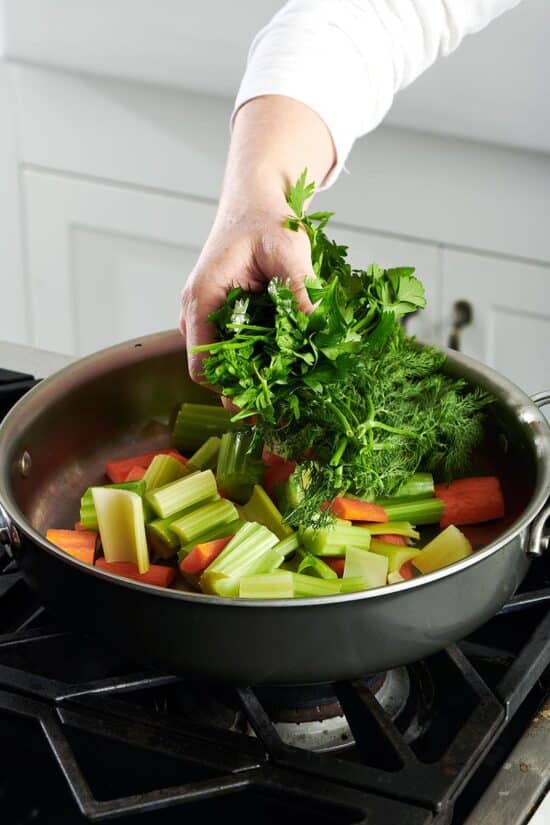
In the case of poached chicken breasts, other herbs like dill, basil, oregano, rosemary, bay leaves, thyme and so on are excellent choices. Just make sure that whatever you are using the finished poached chicken in is a god match for these flavors. As for vegetables, try fennel, garlic, ginger, lemongrass, peppercorns, and hot peppers.
You can also add some beer or dry white wine to the poaching liquid for more flavor. Avoid red wine, which will turn your chicken a notably pink color.
Asian Poached Chicken Breasts
If you know you are adding your poached chicken to a dish with an Asian bent, then you can definitely lean more into the Asian seasonings. Ginger, garlic, lemongrass, scallions, peppercorns (maybe even Szechuan peppercorns), a splash or two of soy sauce, these are all good additions to the cooking liquid.
How to Use Poached Chicken Breasts
You can use them in salads, sandwiches, casseroles, hot pastas and pasta salads, quesadillas, tacos, and enchiladas. You can slice them into sandwiches, or add them to a grain bowl. The texture of poached chicken is soft and tender and consistent and the flavor is quite delicate, allowing other flavors to shine through. You can use poached chicken in any way that you would use other simple cooked chicken.
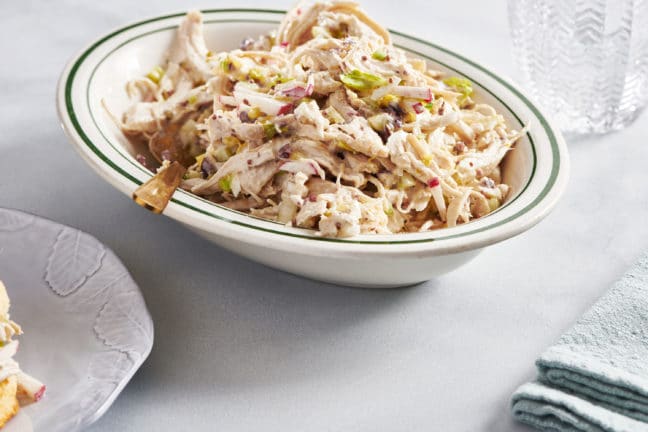
How to Store Poached Chicken
You can store poached chicken, whole, cubed, or shredded for up to 4 days in the fridge. Sealed in an airtight freezer proof container or bag it will last for up to 4 months.
Recipes with Poached Chicken Breast:
Poached chicken breasts can be used sliced in sandwiches such as: Chicken, Bacon and Avocado Spread Sandwich and Chicken Caesar Wrap.
Or in pasta recipes such as: Chicken Parmesan Baked Ziti, Chicken Tettrazini, Easy Chicken Marsala Pasta, Chicken Piccata Orzo Salad, Chicken Caesar Pasta Salad.
Or in salads, such as: Best Chicken Salad, Smoky Chipotle Chicken Salad, Herbed Chicken Salad, Chicken Avocado Salad, Chicken and Rice Salad.
Try poached chicken in quesadillas: Barbecued Chicken Quesadillas, Easiest Baked Chicken Quesadillas, Easy Rotisserie Chicken Quesadillas.
How to Poach Chicken
In a deep skillet large enough to hold all of the chicken in a single layer, add the celery, carrots, parsley, peppercorns, salt and herbs.
Add 6 cups of water, or enough to just cover the tops of the chicken. Bring to a boil over high heat, then reduce the heat and allow the liquid to simmer for 10 minutes.
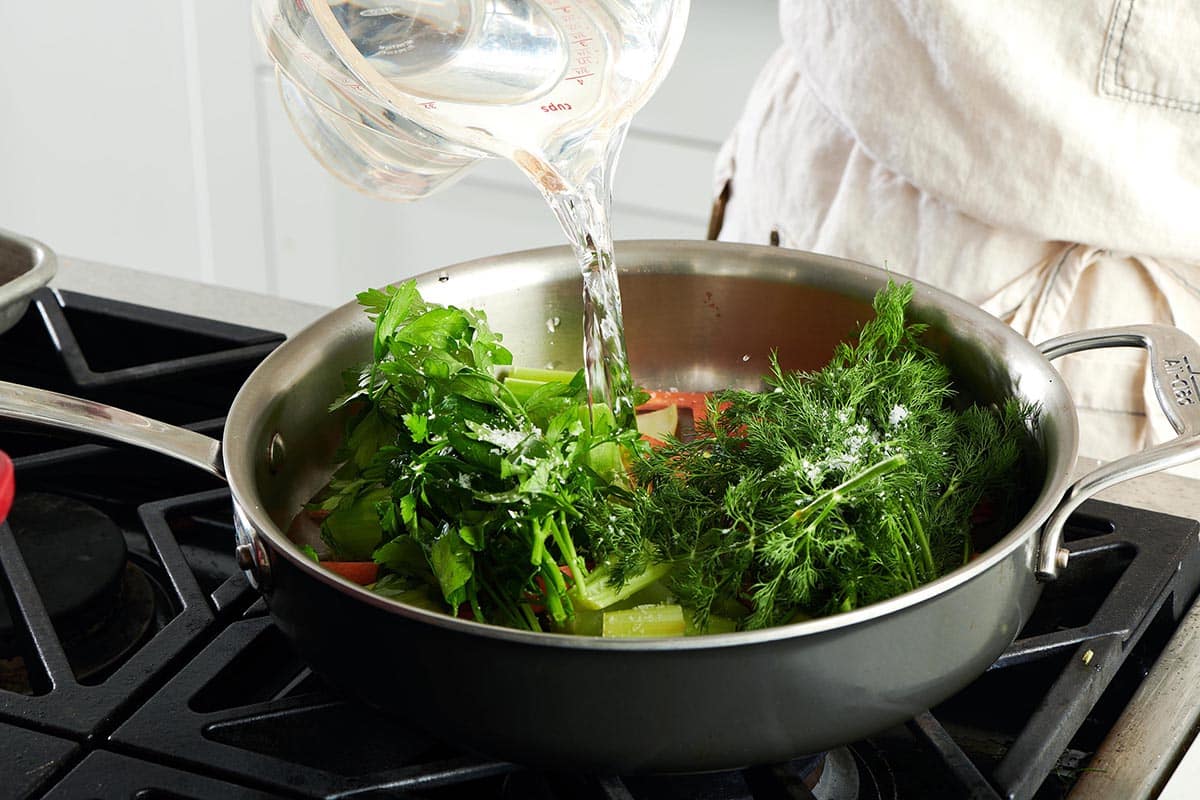
Add the breasts, nestling them in so that they are covered by the liquid. Return the liquid to a simmer.
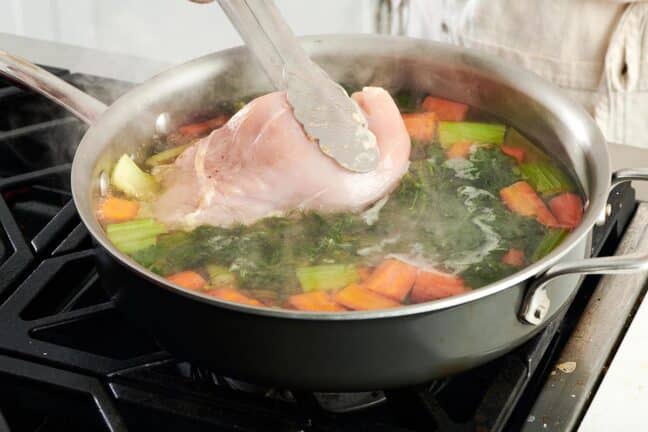
How Long to Poach Chicken Breasts
Cover the pan, lower the heat, and simmer until the breasts are cooked through, about 13 to 15 minutes for bone-in breasts, 6 to 10 minutes for breasts or cutlets (the thicker the chicken, the longer it will take). Adjust the heat as needed. Do not allow the liquid to come to a boil, which can make the breast meat toughen. When it’s done, the chicken should be springy when you press it.
Remove the chicken from the pan. Strain the cooking broth and cool. Save the broth for use in soups or other recipes that call for chicken broth or stock (see below). Allow the chicken to cool to room temperature and serve or use in a recipe as directed.
Broth From Poaching Chicken
The strained broth can be stored in the fridge in a tightly sealed container for up to 4 days. It can also be frozen for up to 9 months. Freeze the broth in small freezer-proof containers for easiest use, or perhaps freeze some of the broth in ice cube trays. When the cubes are frozen, transfer them to a freezer proof zipper top bag and continue to store in the freezer.
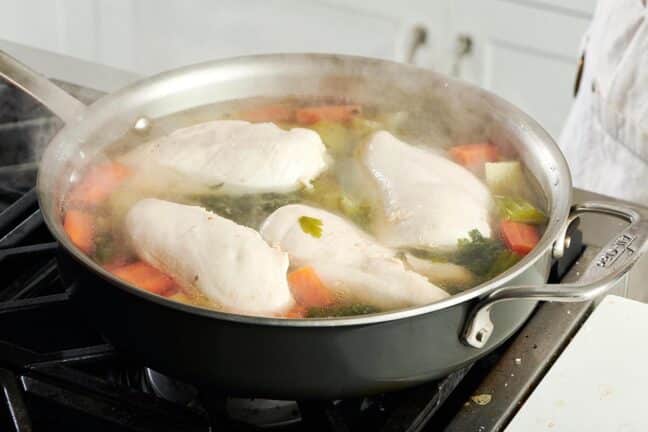
You can use this broth in soups, casseroles, sauces, and so on. Keep the flavors of the broth in mind (and mark them on the label, especially if you are freezing the broth for another time!)
How to Poach Chicken: Perfect tender, delicate, moist poached chicken every time.
Tweet This
How to Tell If Poached Chicken is Done
If the chicken is opaque white throughout, without any pink (or just the faintest hint of pink at the very center, it will continue to cook in its own heat for a few minutes after being removed from the simmering broth), it is cooked through. The chicken should feel springy to the touch. If your chicken breasts are very thick or large you will need to add some extra time to the cooking.
Also see:
Pin this now to find it later
Pin It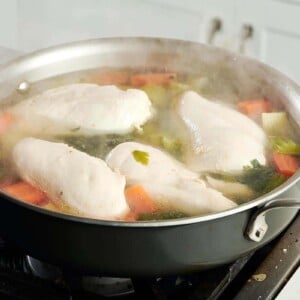
How to Poach Chicken
Ingredients
- 2 celery stalks , cut into 2-inch pieces
- 1 carrot , peeled and cut into 2-inch pieces
- 6 sprigs parsley , approximately
- 6 black peppercorns
- ½ teaspoon kosher salt
- 4 to 6 fresh herb sprigs , such as dill, thyme, or tarragon (optional)
- 6 (about 8 ounce) bone-in chicken breasts (skin on or off) or 6 (6-ounce) boneless skinless chicken breasts
Instructions
- In a deep skillet large enough to hold all of the chicken in a single layer, add the celery, carrots, parsley, peppercorns, salt and herbs. Add 6 cups of water, or enough to just cover the tops of the chicken. Bring to a boil over high heat, then reduce the heat and allow the liquid to simmer for 10 minutes. Add the breasts, nestling them in so that they are covered by the liquid. Return the liquid to a simmer.
- Cover the pan, lower the heat, and simmer until the breasts are cooked through, about 13 to 15 minutes for bone-in breasts, 6 to 10 minutes for breasts or cutlets (the thicker the chicken, the longer it will take). Adjust the heat as needed. Do not allow the liquid to come to a boil, which can make the breast meat toughen. The chicken should be springy when you press it.
- Remove the chicken from the pan. Strain the cooking broth and cool. Save the broth for use in soups or other recipes that call for chicken broth or stock (see Note). Allow the chicken to cool to room temperature and serve or use in a recipe as directed.
